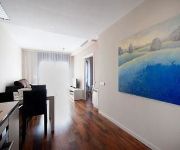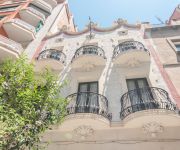Safety Score: 3,0 of 5.0 based on data from 9 authorites. Meaning we advice caution when travelling to Spain.
Travel warnings are updated daily. Source: Travel Warning Spain. Last Update: 2024-08-13 08:21:03
Delve into Horta
The district Horta of Santa Coloma de Gramenet in Barcelona (Catalonia) with it's 26,676 habitants Horta is a district located in Spain about 314 mi east of Madrid, the country's capital town.
In need of a room? We compiled a list of available hotels close to the map centre further down the page.
Since you are here already, you might want to pay a visit to some of the following locations: Barcelona, Ripollet, Sant Cugat del Valles, Badalona and Santa Perpetua de Mogoda. To further explore this place, just scroll down and browse the available info.
Local weather forecast
Todays Local Weather Conditions & Forecast: 17°C / 62 °F
| Morning Temperature | 14°C / 57 °F |
| Evening Temperature | 17°C / 63 °F |
| Night Temperature | 17°C / 62 °F |
| Chance of rainfall | 1% |
| Air Humidity | 52% |
| Air Pressure | 1008 hPa |
| Wind Speed | Fresh Breeze with 17 km/h (10 mph) from East |
| Cloud Conditions | Overcast clouds, covering 90% of sky |
| General Conditions | Light rain |
Friday, 22nd of November 2024
13°C (55 °F)
13°C (55 °F)
Light rain, fresh breeze, broken clouds.
Saturday, 23rd of November 2024
13°C (56 °F)
14°C (57 °F)
Light rain, moderate breeze, broken clouds.
Sunday, 24th of November 2024
17°C (62 °F)
16°C (60 °F)
Scattered clouds, light breeze.
Hotels and Places to Stay
Zoilo Apartments Sagrada Familia
Alimara Barcelona
Le Palacete Relais du silence
Apartamentos Travesera Parc Güell
Weflating Park Güell
Apartments Sata Sagrada Familia Area
Brustar Sant Pau
Catalonia Park Güell
SSG Borne Pop Art Lofts
LM Rooms BCN
Videos from this area
These are videos related to the place based on their proximity to this place.
Stultifera Navis. The visual heritage of the Manicomi de la Santa Creu in Barcelona
In 1401, the City Council and the Deans of the Cathedral of Barcelona (Catalonia, Spain), founded the Hospital de la Sancta Creu (Holy Cross). Between 1401 and 1892 (women) and 1906 (men) about ...
Nou Barris Cabrejada al Ple Extraordinari de Pobresa
Carla, de la Trobada Alternativa de Nou Barris en nom de Nou Barris Cabrejada, Fili Bravo de l'Associació de Veïnes de Ciutat Meridiana, i Toni Tallada, de 500x20, intervenen en el Ple Extraordin...
Intervención en la Audiencia Pública de Nou Barris
Intervención en la Audiencia Pública de Nou Barris del 11 de marzo de 2013. Grabado por Lorena Sopena (@occat93)
Videos provided by Youtube are under the copyright of their owners.
Attractions and noteworthy things
Distances are based on the centre of the city/town and sightseeing location. This list contains brief abstracts about monuments, holiday activities, national parcs, museums, organisations and more from the area as well as interesting facts about the region itself. Where available, you'll find the corresponding homepage. Otherwise the related wikipedia article.
El Carmel
El Carmel, or simply Carmel, is a neighbourhood in the district of Horta-Guinardó, in Barcelona, Catalonia, Spain. Carmel is in the municipal district of Horta-Guinardó. The area was developed mainly in the 60s and 70s when immigrant workers, encouraged to move to Barcelona by the government of the dictator Francisco Franco built housing for themselves.
Can Masdeu
Can Masdeu is a squatted social centre, residence and community garden in the Collserola Park on the outskirts of Barcelona. A former leper hospital which had been abandoned for some 53 years before its eviction, the squat became famous in 2002, when squatters in lockons and on tripods nonviolently resisted the eviction. During a three-day standoff, police were unable to remove the squatters, resulting in the case returning to the courts.
Velòdrom d'Horta
Velòdrom d'Horta is a velodrome in Barcelona, Catalonia, Spain that was the track cycling venue for the 1992 Summer Olympics. It was also the venue for the UCI Track Cycling World Championships in 1984. The velodrome, designed by Esteve Bonell and Francesc Rius, was built in 1984 as the first of Barcelona's construction projects in preparation for the bid for the 1992 Summer Olympics in 1986. It was the first velodrome built to new FIAC rules permitting a 250 m track if surfaced with wood.
Carme Pinós
Carme Pinós (born 1954) is a Spanish Catalan architect. Graduated at the Escuela Técnica Superior de Arquitectura de Barcelona in 1979. From 1982 on she formed a partnership with her husband, Enric Miralles, which ended in 1991. During this period the projects developed include the Igualada Cemetery Park, the Archery Range Buildings for the 1992 Olympic Games and the La Llauna School in Badalona.
Barcelona Metro line 5
— Line 5, currently known as Cornellà Centre - Vall d'Hebron, its termini, and often simply called "Línia Blava" (Blue line) is line belonging to the Barcelona Metro network operated by TMB, and part of the ATM fare-integrated transport network.
La Guineueta, Barcelona
La Guineueta ("The Little Vixen") is one of the nine original neighbourhoods that gave name to the district Nou Barris (literally, nine neighbourhoods) in Barcelona. Actually, the district have 13 neighbourhoods. Its size is about 57 ha. located between Parc Central dels Nou Barris and Parc de la Guineueta, and between Plaça de Karl Marx and Plaça de Llucmajor. Modern construction in the area began in the 1950s, and was settled by migrants from other parts of Spain.
Parc de la Creueta del Coll
Parc de la Creueta del Coll is a park in the Gràcia and Horta districts of Barcelona, Spain. The park was created from an abandoned quarry as part of the nou urbanisme developments during the 1992 Summer Olympics by architects Martorell and Mackay. Today it's distinctly run-down and scruffy. The park contains the sculpture Elogio del Agua, by Basque sculptor Eduardo Chillida, a massive concrete claw suspended by steel cables above a flooded quarry.
Canyelles (Barcelona Metro)
Canyelles is the name of a Barcelona metro station. It's located in the Nou Barris district. It was built in 2001 when the line was extended northbound from Montbau metro station, it lies under Carrer de Federico García Lorca and Via Favència-Ronda de Dalt and is considerably more modern-looking than most of the city's remarkably sober stations. It has two accesses, one on each side of the station.
Horta (Barcelona Metro)
Horta is a station in the Barcelona metro network, served by L5, located under carrer de Lisboa, in the Horta-Guinardó district of Barcelona. It was opened in 1967, when an extension of the line into the neighbourhood of the same name from Vilapicina was opened. The partially curved island-platform station has a ticket hall at either end, one with two accesses, the other with one. Horta was the terminus before the line was extended in July 2010 towards Vall d'Hebron, meeting L3.
Valldaura (Barcelona Metro)
Valldaura is a station on line 3 of the Barcelona Metro, Spain. The station is located underneath Passeig de Valldaura, between Carrer Canigó and Carrer Hedilla. It was opened in 2001. The island-platform station has a single access at Carrer Canigó. Designed by Manel Sánchez, the station is wheelchair-accessible via elevators.
Mundet (Barcelona Metro)
Mundet is a station on line 3 of the Barcelona Metro. The station is located underneath Passeig de la Vall d'Hebron and the Ronda de Dalt expressway, between Avinguda de Can Marcet and Passeig dels Castanyers. Access to the station is provided by an underground passageway allowing passengers to cross under the Ronda de Dalt; access is by stairs, escalators, and elevators north of the station, and level to the south, allowing the station to be supplied with natural light.
Montbau (Barcelona Metro)
Montbau is a station on line 3 of the Barcelona Metro. The station is located underneath Passeig de la Vall d'Hebron, between Carrer de l'Arquitectura and Carrer Pare Mariana. It was opened in 1985 and was the terminus of the line until the extension to Canyelles in 2001.
Vall d'Hebron (Barcelona Metro)
Vall d'Hebron is a station on line 3 and line 5 of the Barcelona Metro. The station is located underneath Passeig de la Vall d'Hebron, between Avinguda Jordà and Camí de la Granja. It was opened in 1985. The side-platform station has a single ticket hall with two accesses. The extension of line 5 opened on 30 July 2010. Near Vall d'Hebron station are the Sant Genís metro yards, which connect to the line on either side of this station.
Virrei Amat (Barcelona Metro)
Virrei Amat is a station on line 5 of the Barcelona Metro. The station is located underneath Plaça Virrei Amat, between Carrer Felip II and Carrer Varsòvia. It was opened in 1959. The curved side-platform station has a ticket hall on either end, each with two accesses.
Vilapicina (Barcelona Metro)
Vilapicina is a station on line 5 of the Barcelona Metro. The station is located underneath Passeig Fabra i Puig, between Carrer Teide and Carrer Petrarca. It was opened in 1959, and served as a terminus until the opening of Horta in 1967. The station has a ticket hall on either end, one with two accesses, the other with one. The station has two platforms and three tracks, the outermost one leading to the nearby train depot.
Roquetes (Barcelona Metro)
Roquetes is a Barcelona Metro station, on line L3. It opened on October 4, 2008 as part of the extension of the metro line from Canyelles into Trinitat Nova. Owing its name to the Roquetes neighbourhood, in the Nou Barris district, the station can be accessed from carrer Jaume Pinent, carrer de les Torres and Parc de Roquetes, near carrer Vidal i Guasch. It's a mixture of a ground-level station with the current deepest sub-surface platform in the system.
Llucmajor (Barcelona Metro)
Llucmajor is a Barcelona Metro station, on L4. Part of the extension of that line from Guinardó into Nou Barris opened in 1982, it takes its name from Plaça de Llucmajor, the central square of the district. It's located under Passeig de Verdum, between the streets carrer de Lorena and carrer de Formentor, and can be accessed from that intersection and from Jardins d'Alfàbia.
Plaça de Llucmajor, Barcelona
Plaça de Llucmajor is a square in Barcelona, unofficially regarded as the nucleus of its Nou Barris district. It's the intersection of three avenues: Passeig de Valldaura, Passeig de Verdum and Via Júlia, Barcelona. Besides, it's the official border between four neighbourhoods of the district: Guineueta, Prosperitat, Porta and Verdum.
Parc del Laberint d'Horta
The Parc del Laberint d'Horta ("Labyrinth Park of Horta", sometimes named Jardins del Laberint d'Horta) is an historical garden in the Horta-Guinardó district in Barcelona, and the oldest of its kind in the city. Located in the former estate of the Desvalls family, next to the Collserola ridge, the park comprises an 18th century neoclassical garden and a 19th century romantic garden.
La Clota
La Clota is a neighborhood in the Horta-Guinardó district of Barcelona, Catalonia.
Montbau
Montbau is a neighborhood in the Horta-Guinardó district of Barcelona, Catalonia. In the eastern part of the neighborhood there is the campus Mundet, which had been the old Llars Mundet that was a charitable organization. In the campus there is the School of Psychology and pedagogy of the University of Barcelona, a geriatric home and schools. In the western part there is the Hospital Universitari Vall d'Hebron one of the greatest sanitary centers of Catalonia and Spain.
El Carmel (Barcelona Metro)
El Carmel is a station on the Barcelona metro network, served by L5. It is part of the extension that opened on 30 July 2010.
El Coll – La Teixonera (Barcelona Metro)
El Coll - La Teixonera is a Barcelona metro station located in the Horta-Guinardó district. The station opened on the 30 July 2010 as part of a 3 station extension to line 5. It is situated on the border between three neighbourhoods, El Carmel, La Teixonera and El Coll. As its name suggest it mainly serves the two neighbourhoods El Coll and La Teixonera even though one of the three station entrances is located in the neighbourhood El Carmel.
Pavelló de la Vall d'Hebron
The Pavelló de la Vall d'Hebron (English: Vall d'Hebron Pavillion) is an indoor venue located in Barcelona. For the 1992 Summer Olympics, it hosted the basque pelota demonstration and the volleyball preliminaries. The building was completed in 1991 for the games.
Tennis de la Vall d'Hebron
The Tennis de la Vall d'Hebron (English: Vall d'Hebron Tennis) is a sports venue located in Barcelona. Modified in 1991, it used only nine of the 17 courts for the tennis competitions of the 1992 Summer Olympics.





























